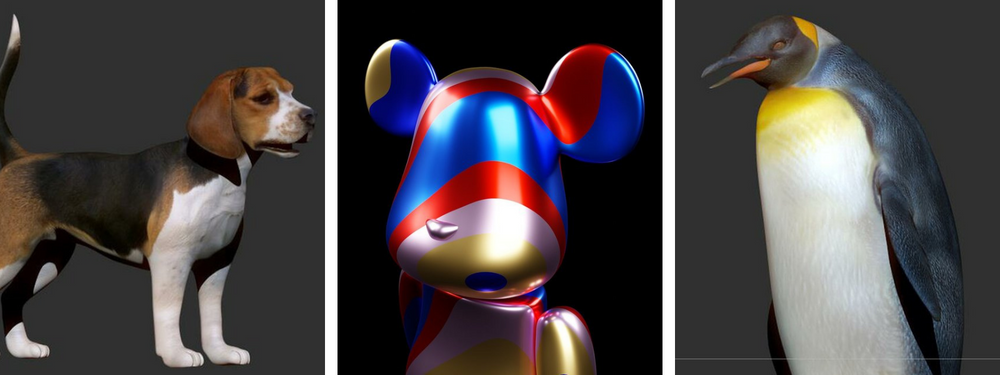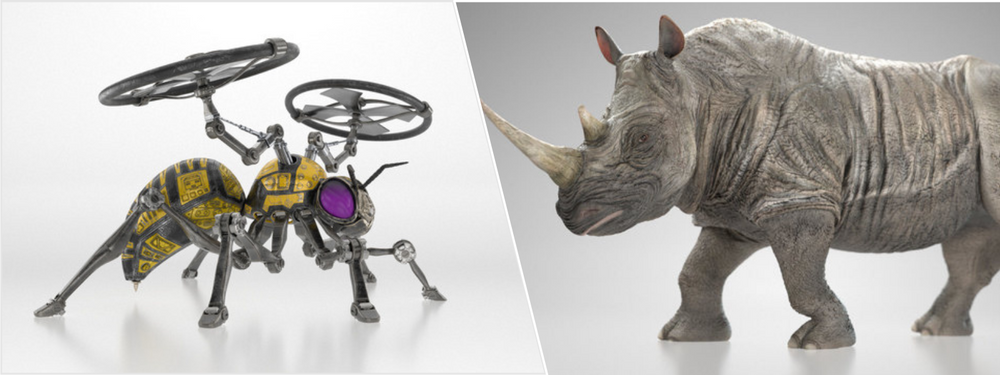An animated 3D model or 3D character can move because it has been rigged. Digital rigs are virtual bones, muscles, and joints to give the 3D model multiple articulation points. In most cases, the skeletal figure of the 3D model is based on the anatomy of a real person or animal to provide it with lifelike motions. Constructing the virtual bone structure of a 3D model is called 3D rigging and can be accomplished using 3D rigging design & animation services.
Any 3D model can be rigged, even when it represents an inanimate object like a pencil, a teapot, a toothbrush, a TV, or a building. Regardless of the object, the virtual bones allow for easy manipulation of the 3D model; think of the bones as strings attached to a marionette. Rigging simplifies and improves the efficiency of the animation process. Animators can control, distort, and transform rigged 3D models as needed.
For example, Randall in Monsters Inc. can walk on two legs but still moves like a chameleon. The 3D modeler and rigger will break down the individual components of the 3D model and insert hundreds of control points to accomplish these movements. Giving the 3D character 3D model the appropriate motion range is impossible without the proper controls in position.
Rigging is most common in entertainment, specifically games, and animations. A good rig should give just the right amount of movability, and the 3D model can be neither too stiff nor too flexible for natural-looking movements.
 Table of Contents
Table of Contents
3D rigging design cost
The 3D rigging design cost here does not represent pricing for developing 3D models and animating them. Most freelance 3D rigging experts cannot give a fixed rate unless they have read the project brief and analyzed the 3D character.
Freelancers typically charge $100 to $120 per 3D character for rigging services. This rate applies to standard 3D characters based on real-life objects, like humans or known animals. Complex or unusual characters/models may require additional articulation points, leading to higher rates. Creatures such as dinosaurs, complex robots, and fantastical/mythical beings with unique body parts can have a more intricate range of motions.
The actual price varies depending on project complexity and quality. As a comparison, a professional 3D rigger working for a big animation studio earns at least $50 per hour. At this rate, the result should be a high-end movie production quality. Some freelance 3D riggers use auto-rigging scripts to speed up the process, so the time commitment is less intense. Automation tools can produce decent quality rigging that is sufficient for most purposes, but it will not suffice for the main 3D character in a TV show or an HD game, let alone a feature film.

RELATED: What Is 3D rigging and how is it used for 3D character animation?
The 3D character 3D modeling process
Depending on the 3D characters’ analysis and the animation platform, the 3D character 3D modeling process may differ from one 3D rigger to another. Still, 3D character 3D modelers follow the primary production stages outlined below.
- 3D models and references
Unless the client provides a ready-made 3D model to rig, the 3D rigging designer may have to create the 3D model from scratch or purchase it for the client. Of course, the purchase price is billed to the client at the end of the process. The 3D rigger needs explicit references to the articulation points, range of motions, and expected poses.
- Skinning
The next step involves “skinning” the 3D model. It begins when it comes to 3D rigging, freelance 3D character modelers usually charge between $100 to $120 per 3D character. This rate applies to 3D characters modeled after real-life objects, like humans or common animals, with standard ranges of motion. The rate may increase for more complex 3D characters or models, such as dinosaurs, complex robots, and mythical creatures due to the need for additional articulation points to support a broader range of movement than a typical human.
These creatures have more complicated movements, often involving additional (if not fictional) body parts with developing the polygonal geometry or bone structure representing the 3D model’s skeleton. The 3D rigging designer creates the bones and joints before configuring the 3D model’s armature. When the skin and bones are all set, it is time to rebuild them again as one 3D model.
- Controllers
To navigate the geometrical forms of the 3D model and understand the effects of motions, the 3D rigger constructs control points using basic three-dimensional shapes. These shapes include:
| Spheres | Rotate controls mainly for the torso, pelvis, and neck |
| Diamonds | Translate and rotate controls for the figure’s central parts, hands, and feet |
| Cubes | Translate controls |
| Trapezoids | Joint controls, specifically for elbow and knee |
The various basic 3D shapes aid in understanding and controlling the operations of the controllers in 3D rigging design and animation services. The shapes also regulate the impacts of every motion on the 3D model’s behavior and posture.
Now that the skeleton design process is completed, the 3D rigger can insert facial expressions and patterns of movement into the reconstructed 3D model. Like a real figure, the bones have hierarchical relation to each other. For example, a shoulder movement will affect the position of a connected arm; hand movement may directly impact the fingers. Because of the hierarchical relationship, the 3D rigger doesn’t have to define all possible motions for 3D model parts.
- Weight Painting
Weight painting is essential to ensure that every movement appears natural and affects the connected parts logically. It involves assigning specific weights to each part of the 3D model to maintain proportion and lifelike 3D characteristics. The assigned weights influence the connected bones during movement, allowing the rigging to adhere to the figure’s natural physiology. This process ensures that the rig behaves realistically and enhances the overall quality of the animation.
- FK (Forward Kinematics) and IK (Inverse Kinematics)
The fifth and final step of 3D rigging involves Forward and Inverse Kinematics configurations. Based on the hierarchical relationship among the bones, movement by any part of the 3D model naturally affects everything that sits lower in the hierarchical chain. For example, the movement of a shoulder requires independent adjustments on the upper arm, elbow, and hand. Such intercorrelation is known as Forward Kinematics, and the adjustments are made manually.
On the other hand, Inverse Kinematics dictates that the motions performed by the lower hierarchical chain automatically determine the position of the upper parts. For example, moving the hands will trigger activities to adjust the rest of the arm, and the computer interpolates the adjustments. Inverse Kinematics simplifies the animation process but doesn’t remove the ability to control all joints independently despite being hierarchically chained.
RELATED: How much does 3D animation cost & rates for product marketing video services?

Pricing Strategies for 3D rigging services
There are several typical pricing strategies for 3D rigging services:
- Fixed price: this is the safest option for establishing project requirements and specifications before starting the work. With a fixed price, the client determines the range of services, expected quality, and timeframe based on their budget. This approach eliminates the risk of exceeding the budget. Moreover, many 3D animation rigging designers are open to negotiating the price. Clients can flexibly prioritize quality or turnaround time based on their preferences.
- Adjustable rate: the cost of 3D rigging services is based on the resources and time spent on the project. Every instance of design change comes with a price re-adjustment. It is difficult to limit the budget, but at least the client can see how much money is going where. An adjustable rate can be the most affordable option, so the client doesn’t mind a longer completion time. The client even has the chance to pause the project anytime and continue as needed.
- Hourly rate: limiting the budget even when using the hourly rate option is possible. It is best for a small project with minimum design revision. It takes several hours to complete a basic 3D rigging setup for a typical human or animal 3D character. However, complex 3D rigging for a set of 3D characters to be featured in a film may take days to complete. Many human and animal 3D characters share identical skeletal figures, so a 3D rigger can use the already available template.
Regardless of the pricing option you choose, make sure to keep clear and regular communication throughout the project. A comprehensive project brief helps minimize the chance of mistakes. Establish milestones and expected deliverables to avoid having too many revisions at the end.
How Rigging Is Used
3D character rigging and animation experts utilize 3D rigging techniques extensively in gaming and animated films. Objects other than human and animal 3D characters can also be animated once rigged. Virtual skeletons can even be implemented into seemingly mundane items like chairs, boxes, and springs.
The 3D model’s rigging must faithfully replicate real-life anatomy for accurate simulations. This enables virtual analysis of the character’s response to impacts like car accidents, falls, etc. Industries like sports can use this method to study the impact on specific body parts during activities like sprints, informing the design of specialized products such as running shoes. The 3D model’s skeletal structure and properties must closely resemble real-life anatomy to ensure precise simulations and reliable results.
Most 3D animation software packages come with rigging features, and the most popular include 3DS Max, Maya, Houdini, and Cinema4D. 3DS Max, known for its comprehensive capabilities, is favored in 3DS Max modeling services. The best free alternative is Blender, an open-source CAD software with everything necessary to create, rig, and animate any 3D model. Although it is not quite as powerful as 3DS Max or Maya (the industry standards), it still has more than enough features to do complex 3D rigging.
How Cad Crowd can help
Discover our extensive network of highly skilled freelancers and experts specializing in 3D rig services. From concept to completion, we provide comprehensive solutions with transparent costs, competitive rates, and flexible pricing options tailored to companies’ and firms’ specific needs.
Don’t miss out on the opportunity to bring your animations to life with our top-notch 3D rigging and animation services. Contact us today for a free quote and unlock the full potential of your projects with our talented team of professionals.
